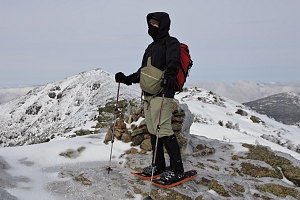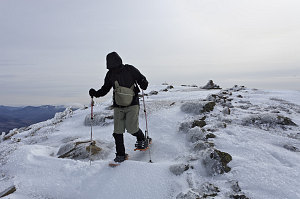After a few more brook crossings, we reached the sharp turn where the Falling Waters Trail abruptly leads up away from Dry Brook, traversing diagonally upwards along a steep slope that leads up to Little Haystack Mountain's summit. From here it was a simple aerobic slog up along nicely switchbacked trail through open forest.
We were thoroughly sweaty by the time we got to the first limited views of the surrounding terrain. The upper part of the Falling Waters Trail then stops with the easy switchbacks, and leads the final few hundred feet of elevation up to treeline by heading straight up. We stopped just before treeline to don a few extra layers and other assorted articles of clothing. We would be out in the open for an extended period of time after this point.
Open Terrain on Little Haystack
Conditions were such that we had fantastic views as we emerged out of the trees and onto Little Haystack's summit. A thin layer of overcast had developed, but it did not completely block out the sun. In various directions below us scattered clouds had gathered, and an undercast of any sort is always something I enjoy. The weather was pretty calm for above-treeline in winter in the Whites - not that far below freezing and only a light breeze from the southeast.
Looking North from Little Haystack
We had arrived at Little Haystack's summit at 12:50pm - a bit later than I would have liked, but still within our limits. One unfortunate development: the ground conditions. There was not a nice fluffy layer of new snow up here; instead, everything was fairly heavily coated in ice.
Although we could have switched to crampons, we chose to give it a shot with the Lightnings. They had fairly agressive cramponing, and as long as the slopes we encountered had some give to them and/or were not too steep, we figured we could manage. So, off we went to the north.
The walk along the ridge was beautiful, as always. The ice-plastering of everything lent an extra sense of ruggedness; and the snowshoes, for the most part, did a good job on the terrain all the way up to the summit of Lincoln (the summit of Lincoln is one of the sub-peaks encountered along the way to Mount Lafayette). Chris exhibited great skill and finesse, sometimes attempting to translate downhill ski moves into snowshoe maneuvers.

Chris on Lincoln
We passed two groups of south-bound hikers on the way north along the ridge. The first had come over Lafayette, and warned us of a steep icy section on the far side that was exposed and which one member of the group termed a "no fall zone". The second group had originally been north-bound (like us), but had turned around when one member of their party had taken a forty-foot slide on a [different] icy slope, slightly injuring herself. She didn't have an appetite for continuing, so they had turned around.

Crunching through icy terrain
We continued north, cresting the summit of Mount Lincoln and getting our first full view of Lafayette itself, half a mile further north. We started to encounter steeper and longer stretches of snow encrusted with an increasingly harder layer of ice, and it became apparent to me that continuing to get by on our snowshoes alone was probably not the safest course of action. Crampon time.

Towards Lafayette
Switching to crampons was indeed a good idea; however, there was unfortunately a small wrench thrown into the situation. Or, I should more properly say, a small nut. On the drive down, I had asked Chris to dry-fit a set of crampons that I lent him. I wanted to be sure that the crampons were properly adjusted to his boots before setting out; there's nothing worse than extended gear fumbling high up in the mountains when your hands are cold and the wind is blowing.

Sketchy
In any case, we unfortunately managed to lose the nut that helped secure the end of one crampon. We tried to locate the nut in the car, but to no avail. I quickly improvised with a bit of duct tape. However, now here on the ridge, faced with steep terrain that could cause an actual injury, I was less sure of the bolt that I had flimsily taped in place. It probably would hold, I concluded, but if it didn't, having a crampon come off halfway through an exposed bit of climbing wouldn't be good. Really not good. Plus, Chris had never used an ice ax or crampons before, and therefore this wasn't a good time to throw him the curveball of having to climb with only one crampon!
I like to use the 'safety dominoes' imagery when describing risk evaluations. In this case, a number of dominoes had fallen; however, this 'nut domino' was the one that tripped the switch for me: I suggested that the best course of action was to turn around and downclimb the way we'd come.